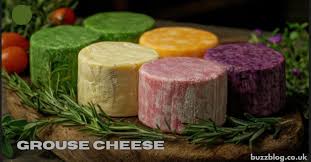Grouse Cheese: From Farm to Fork
If you’re a food enthusiast, the phrase “grouse cheese” might instantly spark curiosity. It’s one of those culinary treasures that blends tradition, wild flavors, and artisanal craftsmanship into a taste experience you won’t forget. Whether you’re exploring cheese pairings with game meat or discovering artisan cheeses inspired by wild landscapes, grouse cheese offers a story that begins on the farm and ends on your fork.
From the highlands where animals roam freely to the rustic kitchens where skilled cheesemakers work, grouse cheese embodies the marriage of nature and culinary artistry. This article will take you on a journey, exploring everything from the best cheeses for wild game to the nutritional benefits, origins, and pairing tips, helping you appreciate why this unique cheese is becoming a gourmet favorite.
What Is Grouse Cheese?
At first glance, the term “grouse cheese” might seem puzzling. Is it a cheese made from grouse? Or is it a cheese that pairs perfectly with this wild game? The truth is a little of both.
On one hand, grouse cheese can refer to the artisanal cheeses produced in highland or rural regions, often inspired by the rugged, wild landscapes that grouse inhabit. These cheeses are crafted using raw milk, wild herbs, and traditional methods that give them their earthy, nutty, and sometimes herbaceous flavor profiles.
On the other hand, the term is also used in the culinary world to describe cheese pairings that complement the rich flavors of grouse meat. This includes cheeses with earthy flavors, nutty varieties, and herbal notes, all carefully chosen to enhance roasted or smoked game dishes.
The Two Faces of Grouse Cheese
1. The Gourmet Pairing Concept
When it comes to grouse meat, pairing it with the right cheese can elevate your dining experience. Chefs around the world recommend bold, aged cheeses that complement the earthy, slightly gamey taste of grouse. Some of the top pairing options include:
- Aged Cheddar – Its sharpness and nutty undertones balance the richness of roasted grouse.
- Smoked Gouda – Adds a creamy texture with a smoky finish that enhances the meat’s flavor.
- Blue Cheese – Offers a bold, salty counterpoint that intensifies the natural gaminess.
- Gruyère – Sweet, slightly salty, and perfect for melting into sauces served with game.
Other considerations include cheeses with herbal notes or earthy flavors, perfect for creating layered tasting experiences. Whether on a charcuterie board or incorporated into grouse recipes, these cheeses bring depth and complexity to the table.
Bullet point highlights for pairing:
- Cheese for roasted dishes
- Cheese for game meats
- Aged cheese pairings
- Nutty cheese varieties
- Cheese with herbal notes
2. The Artisan Highland Cheese
The other side of grouse cheese is its artisanal identity, rooted in regions like the Scottish Highlands and rural Europe. Here, cheesemakers embrace traditional cheesemaking methods to create raw milk cheeses with rich, nuanced flavors.
Characteristics of these cheeses often include:
- Semi-hard texture with a creamy finish
- Herbaceous and earthy taste, influenced by wild landscapes
- Aging in natural caves or cellars to develop unique flavor profiles
These cheeses are crafted using milk from animals that roam freely and forage in wild terrains, resulting in cheese from free-roaming animals and cheese from wild forage. Some varieties even include herbs picked from surrounding wild landscapes, adding subtle hints of flavor that make each bite truly special.
Why Grouse Matters: The Game Bird Connection
To understand the full story of grouse cheese, it helps to know a bit about grouse meat. Grouse, especially the ruffed grouse, is prized for its rich, earthy flavor and tender texture. This game bird has long been a staple in wild game bird cooking, often appearing in pheasant and grouse dishes across European cuisines.
Nutritional benefits of grouse meat:
- High in protein
- Low in fat
- Rich in vitamins and minerals
For gourmets, pairing grouse meat with complementary cheeses unlocks new layers of flavor, transforming a simple meal into a memorable culinary experience.
Best Cheeses to Pair With Grouse Meat
Using the main keyword naturally for SEO: “Best Cheeses to Pair With Grouse Meat”. This section explores cheeses that elevate the dining experience.
- Aged Cheddar: Sharp, bold, and nutty, cheddar balances the gaminess of grouse.
- Smoked Gouda: A creamy, smoky addition perfect for sauces or sides.
- Blue Cheese: A bold choice, ideal for adventurous palates.
- Gruyère: Melts beautifully into sauces, complementing roasted game dishes.
Additional pairing tips:
- Combine cheeses with roasted grouse dishes for earthy undertones.
- Serve cheeses with wine or dark ale to create a gourmet experience.
- Experiment with nutty cheese varieties or cheeses with herbal notes for a unique twist.
How Grouse Cheese Is Made
For those curious about artisan cheese production, the process of creating grouse-inspired cheeses is both traditional and meticulous.
Steps involved:
- Selecting Raw Milk – Often sourced from cows, goats, or sheep that graze freely in mountainous or wild landscapes.
- Incorporating Herbs and Natural Flavors – Wild herbs, foraged from local landscapes, add earthy or herbal notes.
- Curd Formation and Pressing – Techniques vary, but traditional methods ensure texture and taste develop naturally.
- Aging – Cheeses are aged in caves or controlled environments to allow washed rind cheese and semi-hard varieties to mature.
This attention to detail ensures that each wheel of grouse cheese carries the essence of its environment, connecting the diner to the land it originated from.
Flavor and Texture Profile
The flavor of grouse cheese is truly a reflection of its origin. Depending on the specific variety, you might experience:
- Earthy notes reminiscent of the Highlands or forested grazing areas
- Nutty undertones that enhance richness
- Herbal hints from wild plants included during production
Texture can vary from semi-soft to firm, often with a creamy finish that melts beautifully when cooked or enjoyed on a cheese board. These flavors make it ideal for pairing with game meats and incorporating into traditional recipes.
Health-conscious aspects:
- Cheese with probiotics for gut health
- Calcium-rich cheese for bone health
- Protein-rich cheese for energy and muscle repair
Serving and Pairing Ideas
Once you have your grouse cheese, knowing how to serve it can make all the difference. Its earthy, nutty, and herbal flavors shine best when paired thoughtfully with other foods and drinks. For a gourmet charcuterie board, consider combining grouse cheese with cured meats, fresh fruits, and artisanal breads. The contrast of textures—creamy cheese, tender game, and crisp accompaniments—creates a sensory delight.
For wild game dishes, incorporate grouse cheese into sauces or stuffings to enhance the natural flavors of the meat. Some pairing ideas include:
- Cheese with roasted grouse dishes – melt semi-hard varieties for a creamy complement
- Cheese for game meats – bold, aged cheeses like cheddar or blue balance the gaminess
- Cheese with herbal notes – pair with lightly seasoned roasted birds for a nuanced flavor profile
- Nutty cheese varieties – enhance both the texture and taste of pheasant and grouse dishes
When it comes to beverages, red wines with earthy undertones, dark ales, or even whiskeys provide a robust pairing that enhances both the cheese and the meat. These combinations bring out the full flavor potential of grouse cheese and its game companions.
Cultural Significance and Origins
The charm of grouse cheese is deeply tied to its origins. In Scotland, the Highlands provide a perfect environment for animals to roam freely and forage naturally. The same principle applies in parts of rural Europe, where European artisan cheeses have long been celebrated for capturing the essence of local landscapes.
Artisan cheesemakers use traditional methods passed down through generations, embracing the land and the seasonal rhythms. Using milk from animals that graze in wild landscapes, these cheeses develop unique characteristics that cannot be replicated in mass-produced varieties. The highland environment contributes to flavors that are both nutty and earthy, often accented with subtle herbal notes from the wild herbs consumed by the animals.
Some of the regional highlights include:
- Scottish cheese – influenced by rugged terrains and natural grazing
- Highland cheese – bold flavors with a creamy texture
- Cheese from rural regions – reflecting the terroir and traditional cheesemaking methods
- Cheese from mountainous regions – firm texture, aged naturally
- Cheese from free-roaming animals – deeper flavors due to natural diet
- Cheese from wild forage – herbaceous hints in every bite
This focus on authenticity and terroir ensures that grouse cheese is more than just food, it’s a connection to the land, the animals, and centuries of cheesemaking tradition.
Availability and Buying Tips
Finding genuine grouse cheese can be challenging because of its artisanal nature and limited production. It’s rarely stocked in mainstream supermarkets, so your best options are:
- Specialty cheese shops – often carry small batches of highland or rural artisan cheeses
- Online retailers – some Scottish and European producers ship internationally
- Farm markets and artisan fairs – a chance to meet producers and taste fresh varieties
When shopping, look for:
- Labels indicating raw milk cheese or unpasteurized cheese
- Origin information such as Scottish Highlands or rural European farms
- Specific notes about aging, herbal inclusions, or washed rind cheeses
Because of its limited availability, grouse cheese often comes in small batches, making it a rare treat for gourmet food enthusiasts. Its rarity is part of its charm, making each bite an opportunity to savor something truly unique.
Nutritional Benefits
Beyond its incredible flavor, grouse cheese provides a host of nutritional benefits. Depending on the specific type, you can enjoy:
- Protein-rich cheese – supports muscle repair and energy
- Calcium-rich cheese – promotes bone health
- Vitamin B12 content – essential for overall energy and metabolism
- Probiotics – supports gut health and digestion
Even as a gourmet indulgence, grouse cheese offers a balance of flavor and nutrition, making it suitable for anyone interested in wholesome, high-quality food. Incorporating it into your diet, whether in game bird dishes or as part of a cheese platter, allows you to enjoy both the taste and the health benefits.
Exploring Grouse Recipes
The versatility of grouse cheese allows it to be used in a variety of recipes that highlight both its flavor and texture. Some popular ways to incorporate it include:
- Stuffed grouse breasts – filled with nutty or herb-infused cheese
- Cheese sauces for roasted game – melted blue or cheddar cheeses complement the rich flavor of grouse meat
- Savory tarts or pies – combine cheese with herbal notes and roasted vegetables
- Cheese boards and platters – pair with fruits, nuts, and game meats for a fully rounded experience
Using these recipes, home cooks and professional chefs alike can create dishes that showcase the unique qualities of grouse cheese while pairing naturally with its intended culinary companions.






